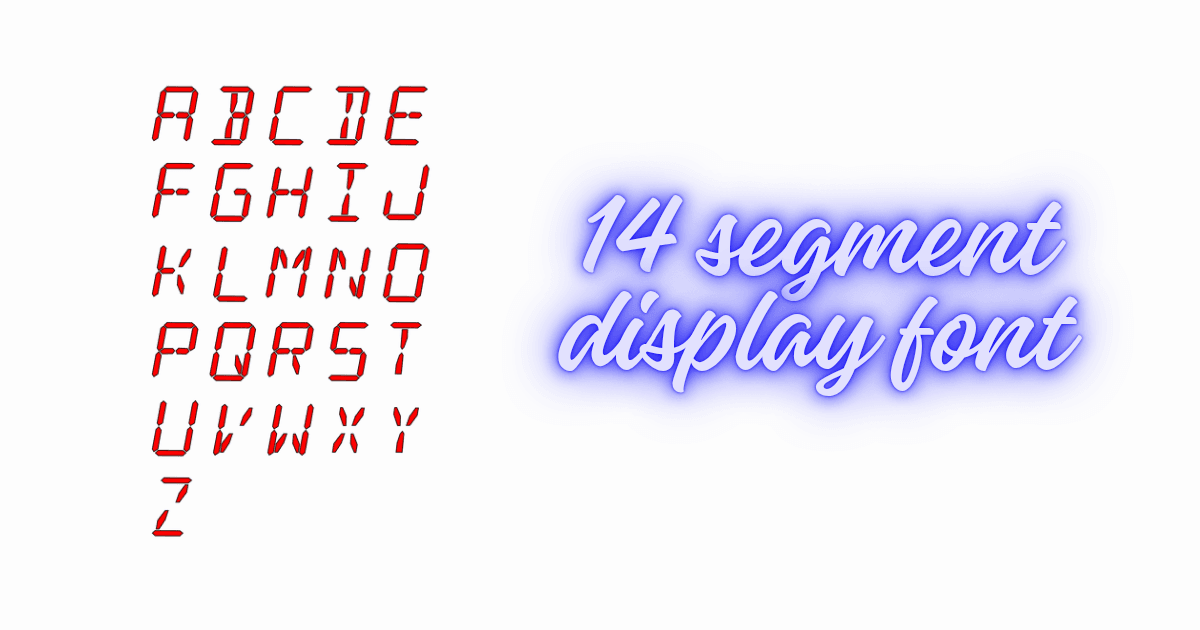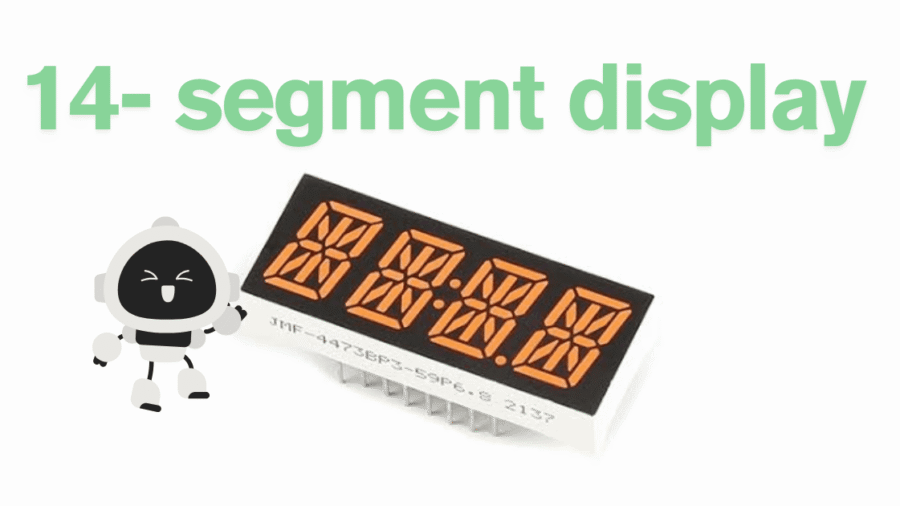In the realm of electronic displays, few components have played as pivotal a role as the 14 segment display. Revered for its simplicity, clarity, and versatility, the 14 segment display has become a fundamental tool in consumer electronics, industrial applications, and digital communication systems. Whether you’re setting a digital alarm, reading values on a laboratory instrument, or checking a display on your microwave, chances are you’re interacting with a 14 segment display— a powerful blend of design and engineering.
This article dives deep into everything you need to know about this display, from its fascinating history to its technical details, applications, and future relevance. Along the way, we’ll also explore the display’s font and compare it with other types of displays available in market.

A Brief History of Segment Displays
The journey of segment displays began long before the 14 segment display came into existence. Let’s dive into past to know how we arrived at this crucial innovation.
Early Concepts (1900s–1950s)
digital numeric display initially appeared in the early 1900s. Initially, these displays were mechanical in nature, using rotating drums or cards to represent digits.
In 1953, a patent filed by M. B. Snyder proposed a display concept involving segmented lights. This laid the groundwork for future segment display innovations.
The Rise of Advantages of the 14 Segment Display the 7-Segment Display
In 1970, 7 segment display started being used in calculators and clocks due to its simplicity and low cost. However, its limitation was evident—it could display only numeric digits effectively, not the full alphabet.
Entry of 14 Segment Display (Late 1970s–1980s)
As the demand for alphanumeric characters grew—especially in consumer electronics like pagers, microwave ovens, and car stereos—the need for a more versatile display became apparent. The fourteen segment display emerged as a revolutionary solution. It allowed for the full English alphabet to be displayed legibly, along with numeric characters and special symbols.
Adoption Boom
By the 1980s, 14 segment displays had become commonplace.
Their ability to convey both numbers and letters clearly led to
widespread usage across multiple industries, including aviation,
automotive, telecommunications, and home appliances.
This display is engineered to render both numeric and
alphabetic characters by illuminating a specific combination of segments. Each display unit contains 14 individual segments, typically labeled from A to N (excluding I and L to avoid confusion with number 1 and symbols). These segments are arranged in a predefined pattern to form recognizable shapes when lit. Segment Breakdown.
Here’s how the segments work:
- Horizontal Segments: A, G1, G2, D
- Vertical Segments: B, C, E, F
- Diagonal Segments: H, I, J, K
- Center Diagonals or Curves: L, M
These segments are configured in such a way that virtually any Latin alphabet letter and numeral (0–9) can be displayed with clarity.
For example:
- To display the letter “A”, segments A, B, C, E, F, G1, and G2 are activated.
- To display “8”, depending on font style all the 14 segments will be used.
This adaptability is precisely what sets the 14 segment display apart from simpler alternatives.
Types of 14 Segment Displays
There are multiple variants based on the backlight and panel technology:
- LED fourteen segment display (most common)
- LCD fourteen segment display
- VFD (Vacuum Fluorescent Display)
Each has its niche applications based on brightness, energy consumption, and clarity needs.
Applications Across Industries
Consumer Electronics
From early alarm clocks to modern-day smart appliances, the 14 segment display offers a cost-effective solution for displaying time, messages, and statuses. It allows compact devices to provide both numeric and text feedback with ease.
Automotive Industry
Modern vehicles use these displays in dashboards, temperature controls, and entertainment systems to show everything from speed and mileage to song titles and alerts.
Medical Devices
Precision is crucial in medical tools. Blood pressure monitors, ECG machines, and diagnostic displays leverage the fourteen segment display to ensure crisp and clear alphanumeric feedback.
Aerospace and Aviation
In high-stakes environments like cockpits, clarity and legibility are paramount. This is a standard display due to its reliability, quick readability, and robustness.
Industrial Machinery
In factories, where rugged, dust-proof, and glare-free displays are essential, this display dominate control panels and monitoring systems.
14 Segment Display Font: The Key to Legibility
The term 14 segment display font refers to the specific arrangement and stylization of characters that are rendered using 14 segments. Since the display is constrained by predefined segments, the font must be carefully designed to achieve functional and pleasing display.
What Makes a Good 14 Segment Display Font?
Uniformity:
Every character should appear balanced within the same segment framework.
Recognizability:
Despite using straight lines and limited curves, characters must be instantly recognizable.
Consistency Across Languages:
Consistency Across Languages: While primarily used for Latin characters, some 14 segment display fonts support basic Greek, Cyrillic, or mathematical symbols.
Standard Fonts Used
- Segment14: Popular in embedded systems
- DB Segment: Used in dashboard indicators
- Microgramma Segment: A modern adaptation for small devices
These fonts are designed to ensure that even complex words like “ERROR,” “ALARM,” or “SENSOR FAIL” can be displayed with legibility.

Why Fonts Matter
Even though all 14 segment displays use the same base structure, the font determines the readability and elegance of the information presented.
Fourteen Segment Display vs Other Segment Displays
7 Segment Display
- Only shows digits (0–9)
- Cannot form letters like W, M, K clearly
- Limited to numeric-only devices
14 Segment Display
- Can display all letters (A–Z) and digits
- Widely used where both letters and numbers are essential
- Versatile and adaptable
16 Segment Display
- An upgrade of the 14 segment display
- Includes two extra segments for curves
- Used in design-heavy consumer electronics
But here’s the catch: the fourteen segment display remains the industry standard for alphanumeric clarity without overcomplicating circuitry.
Technical Specifications of the 14 Segment Display
The 14 segment display is a specialized type of alphanumeric display designed to show both numbers and characters with clarity. Here’s a technical breakdown of how this display operates.
Display Composition
- Total Segments: 14 independent segments (named A–N, skipping I and L)
- Material: Typically constructed using LED (light-emitting diode) or LCD (liquid crystal display) technologies
- Shape: Rectangular or square
- Size Variants: Commonly 0.28″, 0.39″, and 0.56″ digit heights
Electrical Characteristics (LED Type)
- Current: 10–20mA per segment
- Operating Temperature: -40°C to +85°C
- Drive Type: Multiplexed or direct drive
Pin Configuration
A 14 segment display typically has 18–20 pins:
- Common anode or common cathode configuration
- Each segment is controlled individually
Font Memory
- Embedded systems use a lookup table to convert characters into segment combinations.
- Unicode support in advanced systems ensures multilingual character display.
These parameters help engineers integrate 14 segment displays into everything from low-cost devices to high-reliability industrial systems.
Advantages of the 14 Segment Display
The widespread use of the 14 segment display is no accident. It offers a compelling combination of features that make it ideal for a wide variety of applications.
✅ Alphanumeric Versatility
Unlike the 7-segment display, the 14 segment display can effectively show both numbers and letters—a critical advantage in devices that require more complex messaging.
✅ Simplicity with Flexibility
dot matrix display can be used to display anything , but they need complex logic. The 14 segment display finds the perfect middle ground between functionality and simplicity.
✅Energy Efficient
Especially in LCD variants, fourteen segment display consumes minimal power, which makes it very efficient,when it comes to save energy.
✅High Readability
With optimized fourteen segment display fonts, characters are clear and legible from various viewing angles and lighting conditions.
✅Cost-Effective
Compared to graphical displays, 14 segment displays offer a budget friendly solution for showing essential data without sacrificing quality.
Challenges and Limitations
No technology is perfect. Even the trusted display has a few drawbacks worth noting.
✅Limited Design Flexibility
While most alphanumeric characters are supported, complex symbols, foreign language characters, and graphics cannot be rendered effectively.
✅Static Appearance
In contrast to full dot matrix displays or OLED screens, the fourteen segment display has a somewhat “retro” or utilitarian look. It’s not ideal where rich visuals or animations are required.
✅Segment Fading
In older LED-based displays, uneven brightness over time can make characters hard to read, especially in high-use environments.
Future of the 14 Segment Display
Despite the rise of OLED, e-Ink, and high-resolution LCDs, this display is far from obsolete. Here’s why:
Embedded Systems Growth
IoT and embedded applications often favor low-power, low-cost, and high-reliability displays. This keeps the fourteen segment display highly relevant.
Smart Appliances
From toasters to air purifiers, manufacturers rely on this displays to provide users with simple, effective text feedback without blowing the budget.
Automotive Evolution
Even as infotainment systems become more advanced, instrumentation and backup indicators often retain 14 segment displays for speed, clarity, and safety.
Custom Display Controllers
With the rise of programmable microcontrollers like Arduino and ESP32, DIY projects and industrial designers are adopting 14 segment displays to add clear messaging with minimal overhead.
Conclusion
To summarize, the 14 segment display is a timeless piece of engineering brilliance. Its ability to convey both numerical and textual data using a simple yet elegant arrangement of segments ensures it remains an integral part of modern electronics. Whether you’re designing the dashboard of a spacecraft, building a smartwatch, or simply reading the time on a digital clock, this display continues to serve as a quiet yet powerful communicator.
With its robust design, high efficiency, and continued relevance across industries, there’s little doubt that the 14 segment display will shine on for years to come.
Mule Robotics: Transforming Modern Construction with Intelligent Muscle in 2025
Robot Cart : Amazing Tool To Transform Industries In 2024.
Germanium Transistor: Loaded with Mesmerizing features for 21st century.
How do drone shows work? It’s Cost and technology behind this wonder.
What is the future of RPA developer? : Robotic Process Automation in 2025
RUST : BEST LANGUAGE FOR ROBOTICS in 2025?
10 Reasons Why I Love Robotics
Robot Wheel , Critical part of a robot in 21st century
The Future of AI: Top 7 Latest AI developments
What is the difference between 14 segment and 16 segment
displays?
The 16 segment display adds two extra segments for enhanced
character curves and style, but the 14 segment display remains more
common due to simpler design and similar effectiveness.
What characters can the 14 segment display show?
It can display all numbers (0–9), uppercase and lowercase English
letters (A–Z), and a variety of punctuation marks and symbols using a
suitable 14 segment display font.
Where is the 14 segment display used the most today?
It’s widely used in automotive dashboards, home appliances,
medical equipment, industrial machinery, and consumer electronics
like printers and routers.
Is the 14 segment display outdated technology?
Not at all. While newer technologies exist, the 14 segment display
remains vital due to its simplicity, cost-effectiveness, and reliability

This article provides a comprehensive overview of the evolution and applications of segment displays, particularly the 14 segment display. It highlights the transition from the 7 segment display to the more versatile 14 segment display, which can represent the full English alphabet and special symbols. The text also discusses the various applications of these displays in consumer electronics, vehicles, and medical devices. It’s fascinating to see how such a simple innovation has had a profound impact on technology. How do you think the 14 segment display will evolve with the advancement of digital displays?